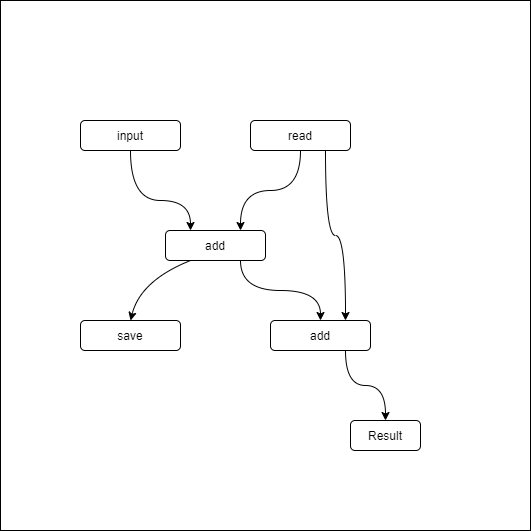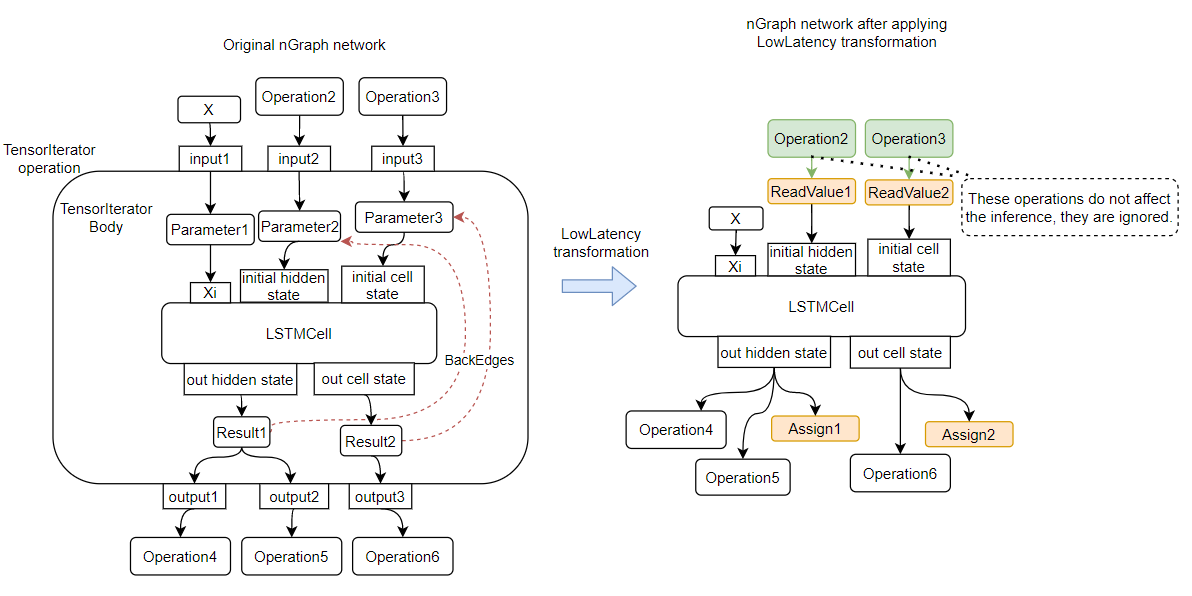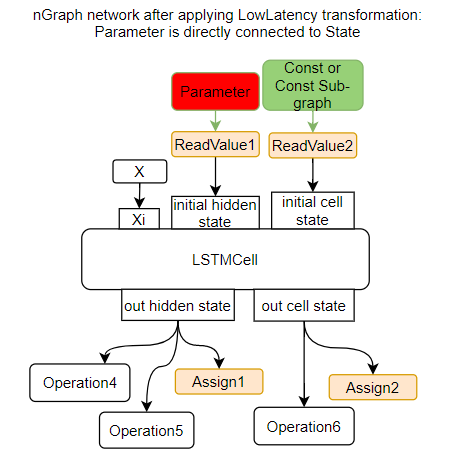This section describes how to work with stateful networks in OpenVINO toolkit, specifically:
- How stateful networks are represented in IR and nGraph
- How operations with state can be done
The section additionally provides small examples of stateful network and code to infer it.
What is a stateful network
Several use cases require processing of data sequences. When length of a sequence is known and small enough, we can process it with RNN like networks that contain a cycle inside. But in some cases, like online speech recognition of time series forecasting, length of data sequence is unknown. Then data can be divided in small portions and processed step-by-step. But dependency between data portions should be addressed. For that, networks save some data between inferences - state. When one dependent sequence is over, state should be reset to initial value and new sequence can be started.
Several frameworks have special API for states in networks. For example, Keras have special option for RNNs stateful that turns on saving state between inferences. Kaldi contains special specifier Offset to define time offset in a network.
OpenVINO also contains special API to simplify work with networks with states. State is automatically saved between inferences, and there is a way to reset state when needed. You can also read state or set it to some new value between inferences.
OpenVINO state representation
OpenVINO contains special abstraction variable to represent state in a network. There are two operations to work with state:
Assign to save value in stateReadValue to read value saved on previous iteration
You can find more details on these operations in ReadValue specification and Assign specification.
Examples of representation of a network with states
To get a model with states ready for inference, you can convert a model from another framework to IR with Model Optimizer or create an nGraph function (details can be found in Build nGraph Function section). Let's represent the following graph in both forms: 
Example of IR with state
The bin file for this graph should contain float 0 in binary form. Content of xml is the following.
<?xml version="1.0" ?>
<net name="summator" version="10">
<layers>
<layer id="0" name="init_value" type="Const" version="opset5">
<data element_type="f32" offset="0" shape="1,1" size="4"/>
<output>
<port id="1" precision="FP32">
<dim>1</dim>
<dim>1</dim>
</port>
</output>
</layer>
<layer id="1" name="read" type="ReadValue" version="opset5">
<data variable_id="id"/>
<input>
<port id="0">
<dim>1</dim>
<dim>1</dim>
</port>
</input>
<output>
<port id="1" precision="FP32">
<dim>1</dim>
<dim>1</dim>
</port>
</output>
</layer>
<layer id="2" name="input" type="Parameter" version="opset5">
<data element_type="f32" shape="1,1"/>
<output>
<port id="0" precision="FP32">
<dim>1</dim>
<dim>1</dim>
</port>
</output>
</layer>
<layer id="3" name="add_sum" type="Add" version="opset5">
<input>
<port id="0">
<dim>1</dim>
<dim>1</dim>
</port>
<port id="1">
<dim>1</dim>
<dim>1</dim>
</port>
</input>
<output>
<port id="2" precision="FP32">
<dim>1</dim>
<dim>1</dim>
</port>
</output>
</layer>
<layer id="4" name="save" type="Assign" version="opset5">
<data variable_id="id"/>
<input>
<port id="0">
<dim>1</dim>
<dim>1</dim>
</port>
</input>
</layer>
<layer id="10" name="add" type="Add" version="opset5">
<data axis="1"/>
<input>
<port id="0">
<dim>1</dim>
<dim>1</dim>
</port>
<port id="1">
<dim>1</dim>
<dim>1</dim>
</port>
</input>
<output>
<port id="2" precision="FP32">
<dim>1</dim>
<dim>1</dim>
</port>
</output>
</layer>
<layer id="5" name="output/sink_port_0" type="Result" version="opset5">
<input>
<port id="0">
<dim>1</dim>
<dim>1</dim>
</port>
</input>
</layer>
</layers>
<edges>
<edge from-layer="0" from-port="1" to-layer="1" to-port="0"/>
<edge from-layer="2" from-port="0" to-layer="3" to-port="1"/>
<edge from-layer="1" from-port="1" to-layer="3" to-port="0"/>
<edge from-layer="3" from-port="2" to-layer="4" to-port="0"/>
<edge from-layer="3" from-port="2" to-layer="10" to-port="0"/>
<edge from-layer="1" from-port="1" to-layer="10" to-port="1"/>
<edge from-layer="10" from-port="2" to-layer="5" to-port="0"/>
</edges>
<meta_data>
<MO_version value="unknown version"/>
<cli_parameters>
</cli_parameters>
</meta_data>
</net>
Example of creating model nGraph API
auto arg = make_shared<op::Parameter>(element::f32, Shape{1, 1});
auto init_const = op::Constant::create(element::f32, Shape{1, 1}, {0});
auto read = make_shared<op::ReadValue>(init_const, "v0");
std::vector<shared_ptr<Node>> args = {arg, read};
auto add = make_shared<op::Add>(arg, read);
auto assign = make_shared<op::Assign>(add, "v0");
auto add2 = make_shared<op::Add>(add, read);
auto res = make_shared<op::Result>(add2);
auto f = make_shared<Function>(ResultVector({res}), ParameterVector({arg}), SinkVector({assign}));
In this example, SinkVector is used to create ngraph::Function. For network with states, except inputs and outputs, Assign nodes should also point to Function to avoid deleting it during graph transformations. You can do it with the constructor, as shown in the example, or with the special method add_sinks(const SinkVector& sinks). Also you can delete sink from ngraph::Function after deleting the node from graph with the delete_sink() method.
OpenVINO state API
Inference Engine has the InferRequest::QueryState method to get the list of states from a network and IVariableState interface to operate with states. Below you can find brief description of methods and the workable example of how to use this interface.
is below and next section contains small workable example how this interface can be used.
std::string GetName() const returns name(variable_id) of according Variablevoid Reset() reset state to default valuevoid SetState(Blob::Ptr newState) set new value for stateBlob::CPtr GetState() const returns current value of state
Example of stateful network inference
Let's take an IR from the previous section example. The example below demonstrates inference of two independent sequences of data. State should be reset between these sequences.
One infer request and one thread will be used in this example. Using several threads is possible if you have several independent sequences. Then each sequence can be processed in its own infer request. Inference of one sequence in several infer requests is not recommended. In one infer request state will be saved automatically between inferences, but if the first step is done in one infer request and the second in another, state should be set in new infer request manually (using IVariableState::SetState method).
std::vector<float> data = { 1,2,3,4,5,6};
for (size_t next_input = 0; next_input < data.size()/2; next_input++) {
MemoryBlob::Ptr minput = as<MemoryBlob>(ptrInputBlobs[0]);
auto minputHolder = minput->wmap();
std::memcpy(minputHolder.as<void *>(),
&data[next_input],
sizeof(float));
inferRequest.Infer();
auto states = inferRequest.QueryState();
auto mstate = as<MemoryBlob>(states[0].GetState());
auto state_buf = mstate->rmap();
float * state =state_buf.as<float*>();
std::cout << state[0] << "\n";
}
std::cout<<"Reset state\n";
for (auto &&state : inferRequest.QueryState()) {
state.Reset();
}
for (size_t next_input = data.size()/2; next_input < data.size(); next_input++) {
MemoryBlob::Ptr minput = as<MemoryBlob>(ptrInputBlobs[0]);
auto minputHolder = minput->wmap();
std::memcpy(minputHolder.as<void *>(),
&data[next_input],
sizeof(float));
inferRequest.Infer();
auto states = inferRequest.QueryState();
auto mstate = as<MemoryBlob>(states[0].GetState());
auto state_buf = mstate->rmap();
float * state =state_buf.as<float*>();
std::cout << state[0] << "\n";
}
You can find more powerful examples demonstrating how to work with networks with states in speech sample and demo. Decsriptions can be found in Samples Overview
LowLatency transformation
If the original framework does not have a special API for working with states, after importing the model, OpenVINO representation will not contain Assign/ReadValue layers. For example, if the original ONNX model contains RNN operations, IR will contain TensorIterator operations and the values will be obtained only after the execution of whole TensorIterator primitive, intermediate values from each iteration will not be available. To be able to work with these intermediate values of each iteration and receive them with a low latency after each infer request, a special LowLatency transformation was introduced.
LowLatency transformation changes the structure of the network containing TensorIterator by adding the ability to work with state, inserting Assign/ReadValue layers as it is shown in the picture below.

Steps to apply LowLatency transformation
- Get CNNNetwork. Any way is acceptable:
- [Reshape](ShapeInference) CNNNetwork network if necessary Necessary case: the sequence_lengths dimention of input > 1, it means TensorIterator layer will have number_iterations > 1. We should reshape the inputs of the network to set sequence_dimension exactly to 1.
cnnNetwork.reshape({"X" : {1, 1, 16});
- Apply LowLatency transformation
...
InferenceEngine::LowLatency(cnnNetwork);
State naming rule: a name of state is a concatenation of names: original TensorIterator operation, Parameter of the body, and additional suffix "variable_" + id (0-base indexing, new indexing for each TensorIterator), for example: tensor_iterator_name = "TI_name"
body_parameter_name = "param_name"
state_name = "TI_name/param_name/variable_0"
- Use state API
Known limitations
Parameters are directly connected to States (ReadValues).
Removing Parameters from ngraph::Function is not possible.

Current solution: replace Parameter with Constant (freeze) with the value [0, 0, 0 … 0] via ModelOptimizer CLI --input or --freeze_placeholder_with_value.
Non-reshapable network.
Value of shapes is hard-coded somewhere in the network.

Current solution: trim non-reshapable layers via ModelOptimizer CLI --input, --output or via nGraph.
auto func = cnnNetwork.getFunction();
auto new_const = std::make_shared<ngraph::opset5::Constant>();
for (const auto& node : func->get_ops()) {
if (node->get_friendly_name() == "name_of_non_reshapable_const") {
auto bad_const = std::dynamic_pointer_cast<ngraph::opset5::Constant>(node);
ngraph::replace_node(bad_const, new_const);
}
}



